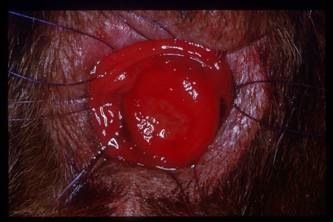PATHOPHYSIOLOGY
CLINICAL FEATURES
+ Biologic Behavior
- Site: distal rectum
- 80% are single lesions and 20% are multiple
- 0%-41% local tumor recurrence rate after surgical resection
- 18% rectal polyps undergo malignant transformation
- Tenesmus, hematochezia, dyschezia, rectal bleeding unassociated with defecation, and polyp prolapse
- Other signs can include vomiting, diarrhea and weight loss
+ Physical Examination
- Abdominal mass is frequently palpable via either abdomen and rectal palpation
- Other findings include dehydration and abdominal pain
+ Laboratory Tests
- Anemia and leukocytosis reported but occur less commonly than small intestinal tumors
- Paraneoplastic leukocytosis reported with adenomatous rectal polyp
+ Endoscopy
- Endoscopy is recommended prior to definitive treatment
- Biopsy samples should be interpreted histologically as cytologic misdiagnosis is common with intestinal ADC being misdiagnosed as either septic inflammation or LSA
- Biopsy samples are often small and superficial resulting in false-negative diagnosis if lesion is either submucosal or associated with surface ulceration and necrosis
TREATMENT
Surgery
+ Surgical Techniques
Surgical approaches: rectal eversion
 transanal endoscopic resection of benign rectal tumors has been described in 6 dogs
transanal endoscopic resection of benign rectal tumors has been described in 6 dogs
+ Cryosurgery
Cryosurgery of pedunculated stalk can be considered with rectal polyps
+ Chemotherapy
Piroxicam (suppository or oral) for rectal tubulopapillary polyps with significant PR or CR in 88% (7/8)
+ Prognosis
- 0%-41% local tumor recurrence rate after surgical resection or cryosurgery
- 18% rectal polyps undergo malignant transformation
- Survival time > 1 year with few deaths related to polyp
- Survival time for polyps diagnosed as carcinoma in situ 5-24 months


